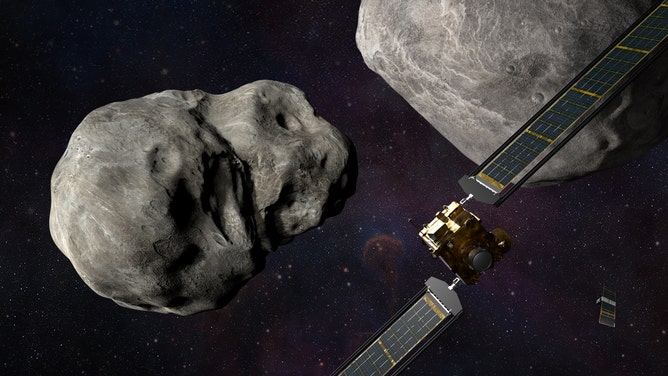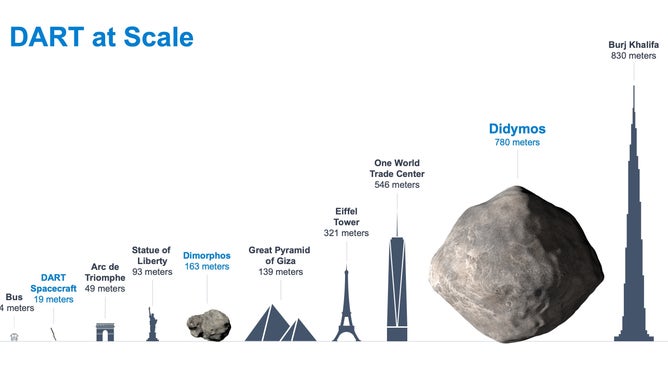NASA's DART spacecraft launches on mission to intentionally smash into asteroid
Falcon 9 liftoff from California begins the first planetary defense mission

Illustration of NASA’s DART spacecraft and the Italian Space Agency’s (ASI) LICIACube prior to impact at the Didymos binary system. Credit: NASA/Johns Hopkins APL/Steve Gribben
(NASA)
VANDENBERG, Cali. – SpaceX provided a ride into space for NASA's DART mission, the first attempt to test out an Earth protection plan from asteroids by crashing a spacecraft into one.
A Falcon 9 rocket lifted off from Vandenberg Space Force Base in California at 10:21 p.m. PT Tuesday (1:21 a.m. ET Wednesday).
After the blastoff, the Falcon 9 booster landed on a drone ship called Of Course I Still Love You in the Pacific Ocean. This marked the third launch for this particular booster. SpaceX also planned to recover both pieces of the rocket nose cone.
DART, which stands for double-asteroid redirect test, is part of a global effort to protect Earth from potentially hazardous asteroids. NASA plans to use DART as a battering ram to crash into a near-Earth asteroid and see if the kinetic energy can change its direction by a tiny amount.
While DART has been receiving some comparisons to the movie "Armageddon," it's far from the fiction depicted in the 1998 film.
The $330 million mission consists of one spacecraft and an Italian Space Agency CubeSat called LICIACube. DART's most important asset is its mass which NASA plans to use to smash into the small moonlet Dimorphos orbiting a larger 780-meter asteroid called Didymos.
LEARN: Why 'Armageddon' plot is not Earth's best defense from asteroids
The asteroids are gravitationally bound to each other. When DART hits Dimorphos, it will slightly change how the pair orbit the sun but only by a tiny amount, according to DART investigation team lead Andy Cheng, with the Johns Hopkins Applied Physics Laboratory. Models indicate the shove by the spacecraft should change its direction by at least 73 seconds.
While most NASA missions last years or even decades, DART's lifespan is relatively short, if all goes well, DART will smash into the asteroid in fall 2022.
The LICIACube will separate from DART 10 days before impact. It will then fly past Dimorphos after the DART crash to capture images of the impact's effects.

An infographic showing the sizes of the two asteroids in the Didymos system relative to some objects on Earth. Credit: NASA/Johns Hopkins APL
(NASA/Johns Hopkins APL)
While Didymos and Dimorphos are not threats to Earth, NASA selected the binary asteroids because the space rocks are relatively close to Earth. Ground-based telescopes can observe the pair, including tracking any change after DART completes its mission.
DART Coordination Lead Nancy Chabot said the team also chose the asteroid duo because it is common in the near-Earth object population.
"It's actually 4.5 billion years old. It formed before the planets formed. It's like the leftovers of planets formation. So that actually makes this asteroid system a really good test in order to do this as well," Chabot said.
MORE: 7 things to know about NASA’s DART mission
DART is one part of NASA’s Planetary Defense efforts. Another is the Near-Earth Object (NEO) Observations Program, designed to find, characterize and track at least 90% of NEOs at least 140 meters. These are about the size of a small football field, according to NASA.
About 40% or 27,000 near-Earth asteroids have been identified, according to the space agency.
While there are no known asteroids 140 meters or larger with a significant chance of hitting Earth in at least 100 years, it's imperative to understand how to deflect one when the time comes.
NASA Planetary Defense Officer Lindsey Johnson said the best time to deflect an asteroid is as far away from Earth as we can.
"The strategy is to find these objects not only years but decades before they're any kind of an impact hazard to the Earth. So we have time to characterize them first and know where they're going to be headed," Johnson said.
While DART's purpose ends at impact, a European Space Agency mission called HERA will launch in 2024 and get a close-up look at DART's impact site with the help of two CubeSats.